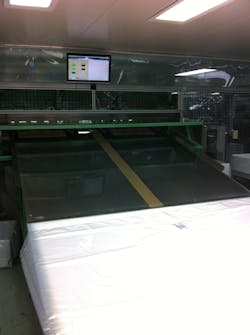As every experienced manufacturing engineer knows, producing quality products is often not enough. There needs to be a way to verify that every unit rolling off the production line is perfect and, if it is not, that it is intercepted before it leaves the facility.
Sealed Air Entapack, an Australian maker of machinery and materials for liquid packaging, found that out when a major customer set the bar high for the large multilayer IBC liners it needed: Ensure that absolutely no visible contamination is trapped between the layers of the liners that it receives.
Entapack manufactures liquid bladders in a positive-pressure clean room where a sophisticated environmental control system removes airborne contaminants. But there is always risk that carbon gels, hair, dirt or an insect will get caught between the layers of plastic making up the liner bags. The clear-plastic liners are up to 2.5 m wide and contaminants can be as small as 50 microns. The plastic film has a tinted coating that darkens the plastic slightly, making it hard for even a vision system to do its job. Minor scratches and abrasions do not constitute serious defects and must be ignored. Liners also come with fitted with two tap fixtures that system needs to recognize and ignore.
Entapack’s existing visual inspection by operators was not adequate for catching 100 percent of defects. Automated optical inspection by machine vision was the only option. But the solution still wasn't easy.
Ideally, to detect very small contaminants over such a large area, the pixel resolution of the machine vision camera needs to be extremely small. However, across a 2.5 m field of view, this equates to a very high number of pixels and requires expensive cameras. On the other hand, there was no need for the cameras to pick up color. Color imaging would have added no benefit and would, in fact, have been detrimental.
Another challenge was the amount of data and size of the image to be processed. The image of a single 2.5 m wide by 2.5 m long bag would contain billions of 50-micron pixels. At the same time, the system was to be built with a single PC, so memory was a limitation. The image would need to be segmented, then processed segment by segment.
To meet these needs, Sealed Air Entapack called on Adept Turnkey Pty, a local engineering firm specializing in machine vision and imaging technology, and CPE Systems, maker of customized, turnkey test systems. Adept investigated the possibility of optimizing the contamination contrast to reduce the high-resolution requirement, and designed custom lighting that enabled the use of 12k line-scan cameras. The resulting system is a standalone inspection station—triggered by bag-presence input from a PLC—that uses an encoder to synchronize line scanning with bag motion. The 12k, 23 kHz line-scan camera is a Piranha3 from Teledyne Dalsa.
Three cameras are mounted over the bag conveyor to provide a line of 36,864 pixels to span the 2.5 m width of the bladder under inspection. Each pixel is considerably larger than the 50-micron defect detection limit originally specified—especially accounting for overlap between camera fields. With Adept’s lighting solution, however, a defect need not fill a whole pixel to be detected. Even contamination particles a fraction of a pixel across will cause sufficient light variation to trigger detection.
CPE integrated the system components and developed certain custom imaging routines as well as custom algorithms that allow the system to isolate and ignore the tap. They also developed a process to identify and ignore any scratches in the tinted coating.
Three Teledyne Dalsa Xcelera frame grabbers interface to the Piranha cameras, and the inspection application was built in Teledyne Dalsa’s Sherlock software environment. Sherlock pre-processors handle the segmented images and help with the inspection tools needed to detect contamination within the computer’s memory constraint. When contamination is detected, the system overlays the image with a location to make diagnostics and remediation easier.
The system has been in use for over a year and is reliably detecting contaminants and signaling operators to take action—proof that Sealed Air Entapack and its partners were able to meet the high bar set by the customer.

